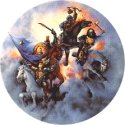|
Recently someone asked me how Yeshua could be understood as a sin offering since the Torah commands that a goat be offered for sins. Well, first it should be noted that the Levitical laws for a sin offering (korban chatat - ū¦ū©ūæū¤ ūŚūśūÉū¬ŌĆÄ) did not require a goat per se, but any one of three different kinds of defect-free kosher animals (bullock, goat, lamb), depending on the circumstances. A turtle dove was also permitted to be offered if the person was very poor. For Yom Kippur, of course, a bullock and two goats were required: one goat was for blood sacrifice in the Holy of Holies (the Goat of God) and the other was used as a "scapegoat" for the sins of the community (the goat for Azazel / the devil). The Gospels emphasize the connection between Yeshua as the "Lamb of God who takes away the sins of the world" with Passover/Exodus more than the connection between Yeshua as the "Goat of God" whose blood is sprinkled upon the Mercy Seat with Yom Kippur - though the author of the Book of Hebrews explicitly makes this connection (Heb. 9:11-12; 24-ff).
Note that the original Passover sacrifice (korban Pesach) was not given to the Levitical priesthood as a sin offering, since it preceded Sinai and the giving of the laws concerning the Mishkan/Temple sacrificial rites. In the same way, Yeshua's sacrifice was directed from Heaven itself by means of the prophetic office of Malki-Tzedek (ū×ųĘū£ų░ūøų╝ų┤ūÖųŠū”ųČūōųČū¦) - a higher order of priesthood (Gen. 14:18; Psalm 110:4; Heb. 7). Yeshua both offered Himself up as the "Lamb of God" that causes the wrath of God to (eternally) pass over those who personally trust in Him, and He also offered himself as the "Goat of God" whose blood was sprinkled in the Holy of Holies to cleanse us from sin and give us (everlasting) atonement. (Other metaphors are also given in Scripture, of course. For example, Yeshua offered Himself as the Snake lifted up (John 3:14-15; cp. Num. 21:4-9), as a Red Cow (parah adumah), and so on).
Yeshua as the "Lamb of God" pictures personal redemption from slavery to Satan and freedom from the wrath of God. This is the greater Passover/Exodus connection. By means of Yeshua's shed blood and broken body, the wrath of God passes over us and we are set free to serve God.... Yeshua as the "Goat of God" pictures both personal cleansing (i.e., "propitiation" or "expiation" for our sins: the Greek word (ß╝▒╬╗╬▒ŽāŽäßĮĄŽü╬╣╬┐╬Į) is used in the LXX for the kapporet (Mercy Seat) in the Holy of Holies which was sprinkled with the blood of the sacrifice on Yom Kippur) as well as national teshuvah and cleansing for ethnic Israel at the end of the Great Tribulation period. At that time Yeshua will function as Israel's true High Priest whose sacrifice is applied for Israel's Atonement. This is the Yom Kippur connection. Moreover, since Yom Kippur points to the removal of the sin-laden goat (representing Satan), the Millennial reign of Messiah will be one unmolested by the powers of evil.

Just as Rosh Hashanah reveals the coming time of Judgment and the rapture of the kehillat Mashiach (Bride of Messiah), Yom Kippur prophetically pictures the Day of the LORD or the Day of Judgment in Acharit HaYamim [the last days]. After the judgment of the nations during the Great Tribulation, national Israel will be fully restored to the LORD and their sins will be purged (see Matthew 24). Indeed, our beloved Mashiach will one day return to Israel, cleanse her Temple, restore her to Himself, and set up His glorious kingdom.
|


